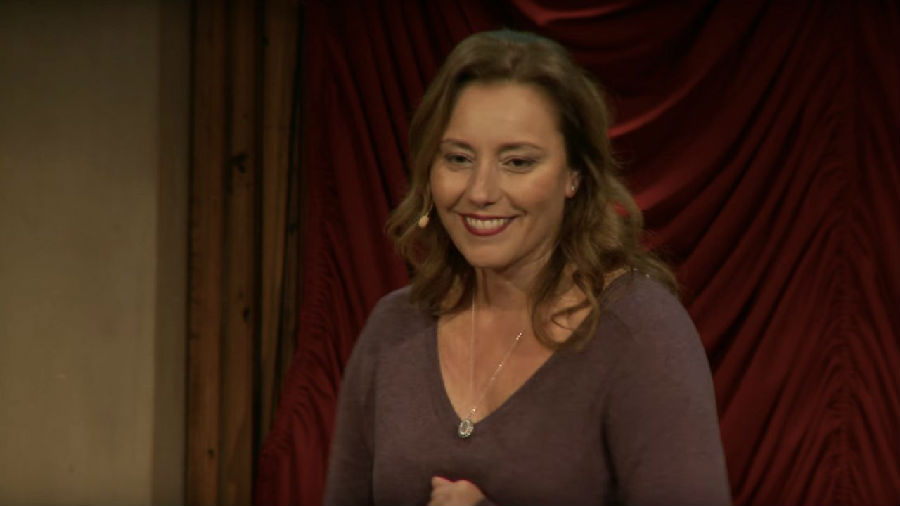As New Yorkers, we're often busy looking up at the development going on around us.
作为纽约人,我们每天都见证着身边的各种发展变化。
We rarely stop to consider what lies beneath the city streets.
但很少有人停下来考虑城市的街道下面有什么。
And it's really hard to imagine that this small island village would one day become a forest of skyscrapers.
你很难想象这个小小的岛上村庄,有一天变成一个钢筋水泥的森林。
Yet, as an urban archaeologist, that's exactly what I do.
然而作为一名城市考古学家,这就是我的工作。
I consider landscapes, artifacts to tell the stories of the people who walked these streets before us.
我看着那些景观和手工艺品,讲述那些在我们之前走在这些街道上的人的故事。
Because history is so much more than facts and figures.
因为历史远不止是事实和数据。
When people think of archaeology, they usually think of dusty old maps, far off lands, ancient civilizations.
人们想到考古学时,总是想到布满灰尘的旧地图、遥远的土地、古老的文明。
You don't think New York City and construction sites.
你不会想到纽约市和那些建筑中心。
Yet, that's where all the action happens and we're never sure exactly what we're going to find beneath the city streets.
然而这就是所有事件的发生地,我们永远也无法确定我们在城市的街道下面会发现什么。
Like this wooden well ring which was the base for the construction of a water well.
就像这个木制的造井用的圆环,它原本被用来做一口水井的地基。
It provided us an opportunity to take a sample of the wood for tree-ring dating,
现在它给了我们机会获得木头的样本,从而阅读年轮,
and get a date to confirm the fact that we had indeed found a series of 18th-century structures beneath Fulton Street.
并且给了我们日期,让我们确认我们确实在富尔顿大街下面发现了一堆十八世纪的建筑物。
Archaeology is about everyday people using everyday objects,
考古学就是关于每个人每天使用什么物品,
like the child who may have played with this small toy, or the person who consumed the contents of this bottle.
比如有个孩子可能玩过这个小玩具,或者有个人喝掉了这个瓶中的水。
This bottle contained water imported from Germany and dates to 1790.
这个瓶中曾经装满了德国进口的水,可以追溯到1790年。
Now okay, we know New Yorkers always had to go to great lengths to get fresh drinking water.
我们知道,纽约人总是想尽办法寻找新鲜的饮用水。
Small island, you really couldn't drink the well water, it was to brackish.
小岛上的井水真的无法饮用,味道太咸了。
But the notion that New Yorkers were importing bottled water from Europe, more then two hundred years ago,
但是纽约人两百多年以前就已经从欧洲进口瓶装水这件事,
is truly a testament to the fact that New York City is a cosmopolitan city,
确实证明了纽约市一直是一个国际大都市,
always has been, where you could get practically anything from anywhere.
在这里你可以得到来自世界各地的任何东西。
If you and I were to walk through City Hall Park, you might see an urban park and government offices.
如果你和我一起走过市政厅公园,你会看见一座花园还有一些政府大楼。
I see New York City's largest and most complex archaeological site.
而我看见的是纽约市最大最复杂的遗址。
And it's significant not because it's City Hall,
它的宏伟不在于它是市政厅公园,
but because of the thousands of poor prisoners and British soldiers who lived and died here.
而在于成千上万个可怜的囚犯和英国的士兵曾在这里生活过,也死在这里。
Before it was City Hall Park, the area was known as The Common, and it was pretty far outside the city limits.
在作为市政厅公园之前,这个地方曾被称作“The Common”,它在城市的界限之外。
In the 17th century, it was a place for public protests and execution.
十七世纪时,人们在这个地方举行抗议和执行死刑。
And its remote location made it an ideal spot for the city to construct its first poor house.
偏远的地理位置让它成为建设第一座救济院的理想地点。
And it's from that period, circa 1735, that we find these bone buttons.
这个物品就来自那个时代,也就是大约1735年,我们发现了这些骨头制成的扣子。

These were made by poor persons in the almshouse.
这些是由居住在救济院的穷人制作的。
Poor persons in the almshouse were assigned various tasks to earn their keep,
这些穷人每天会被分配到各种各样的任务来获取生活物资,
among them, shredding old rope for reuse, dressing hemp, picking oakum, making bone buttons,
其中包括切碎旧的绳子进行二次利用,纺麻绳,拆麻绳,用骨头做纽扣,
in the thought that hard work would reform these poor persons into productive members of society.
政府希望这些穷人可以通过这些工作为社会做出贡献。
The almshouse served several groups: poor needy persons, sturdy beggars, idle wandering vagabonds.
救济院主要生活着各种群体:穷人,彪悍的乞丐,游手好闲的流浪汉。
And reasons to be admitted? Insanity, pregnancy, or being a widow or an orphan who could no longer pay their way.
被接受的标准是什么呢?精神病人,孕妇,还有无法养活自己的寡妇和孤儿。
Which makes this piece all the more interesting.
这使得这个东西更加有趣。
This child's plate was found within the walls of the Bridewell.
这个儿童餐盘是在布莱德威尔监狱的墙里找到的。
The Bridewell was one of the most feared and notorious prisons of its time,
而布莱德威尔是当时最让人害怕、最臭名昭著的监狱之一,
and it happened to have been right next door to the almshouse.
而它刚好就在救济院的隔壁。
In fact, there were prisons on either side of the almshouse, and at times, these institutions were so overcrowded.
实际上,救济院的两边都有监狱,有时监狱还会满员。
Prisoners and poor persons were sharing the same spaces.
囚犯和穷人生活在同一片空间里。
And while there is a lot of clamor about how can you expose children to hardened criminals,
当时有很多的人讨论怎么可以把孩子放到犯罪分子旁边居住,
let's not forget that children as young as twelve were convicted to the Bridewell for stealing bread.
请大家不要忘了,十二岁的孩子已经会因为偷面包被送到布莱德维尔去了。
What all this gives us is an insight into life in the 18th century, what it was like to be poor in the 18th century,
这些帮助我们了解了十八世纪的生活、十八世纪的贫穷是什么样的,
perhaps being segregated from a portion of society, perhaps being assigned tasks to earn their keep.
穷人可能会被从社会中分离开,可能会被分配任务让你维持生计。
It was a time when three-fifths of New York City's population were living at or near the subsistence level, if not below.
当时五分之三的纽约人的生活水平,刚好维持在贫困线上或靠近贫困线,甚至可能低于贫困线。
And 10% of the population owned more than half of the city's wealth.
而百分之十的人口获得了整个城市一半以上的财富。
The past has a lot to teach us about our present and our future.
历史对于我们的现在和我们的未来有很强的教育意义。
I'm a firm believer that in order to have a sustainable future, we must have a well-understood past.
我坚定的相信,要有一个可持续的未来,我们就必须认真的了解过去。
Archaeology affords us New Yorkers and pretty much anyone in an urban center the opportunity
考古学让我们纽约人以及住在城市中心的每一个人有机会
to incorporate the knowledge of our past into our present-day dialogues, into the dialogues about our futures,
将关于我们过去的知识融入到我们当今的讨论中,融入到关于我们未来的讨论中,
incorporate the information into our shared spaces,
融入到我们共同分享的这片空间里,
and hopefully, it can bring all of our diverse communities within New York City, again, within any city closer together.
我希望它可以让我们纽约市的各种文化再一次联结在一起,让每个城市的人都能团结起来。
And if I can get just one person to think a little bit differently about what they see
如果我能让一个人对他看到的一切产生一点不同的想法,
when they walk down the city streets, or through an urban park, then I've done my job of sharing the past. Thank you.
在他们走在城市的街道上,走过一个公园的时候,那我分享过去的工作就算完成了。谢谢大家。











